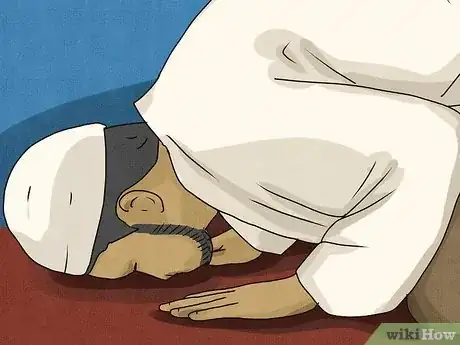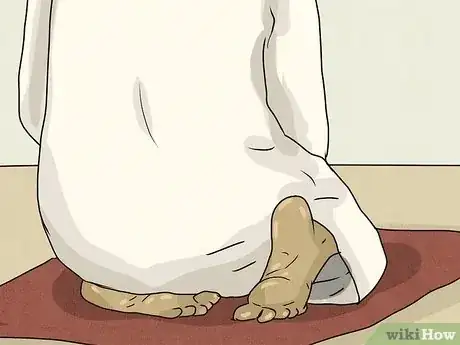This article was co-authored by wikiHow staff writer, Luke Smith, MFA. Luke Smith is a wikiHow Staff Writer. He's worked for literary agents, publishing houses, and with many authors, and his writing has been featured in a number of literary magazines. Now, Luke writes for the content team at wikiHow and hopes to help readers expand both their skillsets and the bounds of their curiosity. Luke earned his MFA from the University of Montana.
This article has been viewed 8,510 times.
Learn more...
Practicing Muslims pray 5 prayers (or “Salah”) throughout the day, and the prayer said at noon is the Zuhr (or “Duhr”) prayer. It consists of 4 Rak’ahs, or parts, and while it may appear somewhat complicated at first, it becomes pretty simple with a little guidance and practice. That’s why we’ve put together a simple guide for saying all 4 Rak’ahs, complete with the prayers, translations, and motions involved in praising Allah.
Things You Should Know
- Wash your hands, face, forehead, and feet before you begin, then set your intention by focusing on Allah and the prayer at hand.
- Stand and face the direction of Makkah while reciting “Allahu akbar” to begin the prayer.
- Begin the Rak’ah by reciting the first chapter of the Qur’an, then progressing through the prayer movements like sitting and prostrating.
- Repeat the first Rak’ah and say an additional prayer to complete the second Rak’ah, then repeat the first 2 Rak’ahs to complete the Zuhr prayer.
Steps
Preparation
-
1Wash your hands, face, forearms, and feet. Before you perform any Islamic prayer, you first perform “wudu,” which is the ritual cleansing of your body done to purify yourself for worship. Wash your hands first, then your face, forearms, and feet.[1]
-
2Focus your mind and set your intention. Your intention, or “niyyat,” is the intention in which you do an act, in this case praying the Zuhr. Take a moment to center yourself and focus on the prayer at hand, quieting your thoughts and preparing yourself to pray with sincerity to Allah.[2]
- Niyyat is done silently, but if you like you can repeat the word “Bismillah” (“in the name of Allah”) in your head to help you focus.
Advertisement -
3Stand facing the direction of Makkah and say “Allahu akbar.” If you’re in the US or the UK, face about southeast. Raise your hands to your earlobes and say the Takbir, which is “Allahu akbar” and means “God is the greatest.” Then place your right hand on your chest and say, “A’oothu billaahi minash-shaytanir-rajeem,” which means, “I seek refuge with Allah from Satan the accursed.”[3]
- When you pray, face the direction of Makkah (also known as “qibla”). If you’re outside the US or UK, find Makkah (or “Mecca”) on a map or visit a Muslim prayer website that will tell you which direction to face.
- After saying the Takbir, refrain from talking, laughing, drinking, eating, visiting the restroom, or anything else that would disrupt your state of prayer.
The First Rak’ah
-
1Recite the first chapter of the Qur’an, then any other passage. The first chapter is also known as the “Surah al-Fatihah.” While standing and with your right hand still over your chest, read or recite the entire passage, followed by any passage (or “surah”) of your choosing. The Surah al-Fatihah is as follows:[4]
- Bismillaahi’r-Rahmaani’r-Raheem / Al-hamdu lillaahi rabbil-`aalameen / Arrahmaanir raheem / Maaliki yawmid-deen / Iyyaaka na`budu wa iyyaaka nasta`een / Ihdinas-siraat al-mustaqeem / siraat al-ladheena an`amta `alayhim / ghayril maghdoobi `alayhim / wa la’d-daalleen / Ameen
- In the Name of God, the Merciful, the Compassionate / Praise belongs to God, Lord of the Worlds / the Merciful, the Compassionate / Master of the Day of Judgement / We worship only You and from You alone do we seek help / Lead us on the straight path / he path of those whom You have blessed / not of those on whom is [Your] Wrath / nor of those who have gone astray / Oh Allah answer our prayer!
-
2Say a Takbir, then bow. Raise your hands to your earlobes and say “Allahu akbar.” Then, bend at the waist (a position known as “ruku”) and say the following 3 times: “Subhaana rabbiyal ‘atheem”. After, stand upright and, as you rise, say, “Sami’-Allaahu liman hamidah.” Now, lower your arms, bow your head, and say, “Rabbanaa wa lakal hamd.”[5]
- These verses translate to, “Glory be to my Lord the Supreme,” “Allah listens to the one who praises Him,” and “Our Lord, and to You belongs the praise,” respectively.
-
3Place your forehead to the floor and say 3 Takbirs. Lower yourself to your hands and knees with your nose and forehead touching the ground (a position known as “sujud”) and say, “Allahu akbar” 3 times. Then say, “Subhaana rabbiyal ‘alaa” (“Glory be to my Lord Most High”).[6]
- While in sujud, keep your palms flat on the floor, your knees together, and your feet upright with your toes in contact with the floor.
-
4Sit on your heel and say a Takbir, then “Rabbighfirlee.” While resting your weight on your left thigh, rest your left foot parallel to the floor and keep your right foot perpendicular and upright, with your toes bent forward toward the Qiblah.[7] Place your hands on your knees and say, “Rabbighfirlee” (“Oh Allah, forgive me”).[8]
-
5Return to sujud and say a Takbir. Lean forward into a prostration and recite “Allahu akbar,” followed by “Subhana Rabbiy-al-Aalaa” (“Glory be to my Lord, the Highest”) 3 times. This completes the first rak’ah.[9]
The Second Rak’ah
-
1Stand and repeat the first Rak’ah. To perform the second Rak’ah, stand from sujud , raise your hands to your earlobes and say a Takbir. Then, repeat the entire first Rak’ah from the start, beginning with the Surat al-Fatiha and continuing all the way through the final sujud.[10]
-
2Kneel and raise the index finger of your right hand. After the final sujud, sit upright as before, with your weight on your left thigh and your feet aligned properly, palms on your knees, and lift the pointer finger of your right hand.[11]
-
3Recite the Tashahud. While sitting with your index finger raised, say, “At-tahiyyatu lillah, was-salawaatu wat-tayyibaat. As-salaamu ‘alayka ayyuhan-Nabiyyu wa rahmat-Ullahi wa barakaatu. As-salaamu alayna, wa alaa ibaadi-llahis salient. Ashhadu an laa ilaaha ill-Allahu wa ashhadu anna Muhammadan abduHu wa Rasooluh.”[12]
- This means, “All compliments are for Allah, and prayers and goodness. Peace be upon you, O Prophet, and the mercy of Allah and His blessings. Peace be upon us and on the righteous servants of Allah. I bear witness that there is no god but Allah and I bear witness that Muhammad is His servant and messenger.”
The Third and Fourth Rak’ahs
-
1Perform the first Rak’ah again. To perform the third Rak’ah, repeat the first Rak’ah from the Surat al-Fatiha through the final sujud. Instead of the Surat al-Fatiha, you might say the al-Tasbihat al-Arba’ah 3 times, as follows: “ Subhaanallaahi wa’l hamdu lillaahi wa laa ilaaha illallaahu wallaahu akbar” (“Glory be to God, and praise be to God; there is no god but Allah, and Allah is Greater”). This completes the third unit of the Zuhr prayer.[13]
-
2Perform the second Rak’ah again. To complete the fourth Rak’ah, simply perform the second Rak’ah again, including the recitation of the Tashahud. This is the final Rak’ah of the Zuhr prayer.[14]
-
3Sit with your palms on your knees. While sitting on your heels with your right index finger extended, say, “Allahumma salli alaa Muhammadiw wa alaa aali Muhammadin, kamaa sallayta alaa Ibraheema wa alaa aali Ibraheema, innaKa Hameedum Majeed. Allahumma baarik ‘alaa Muhammadiw wa alaa aali Muhammadin, kamaa baarakta alaa Ibraheema wa alaa aali Ibraheema, innaKa Hameedum Majeed.”[15]
- This translates to, “O Allah, send Your mercy upon Muhammad and the family of Muhammad, just as You sent mercy upon Ibrahim and the family of Ibrahim. Truly You are Praiseworthy and Glorious. O Allah, send blessings upon Muhammad and the family of Muhammad, just as You sent blessings upon Ibrahim and the family of Ibrahim. Truly You are Praiseworthy and Glorious.”
-
4Complete the prayer with the Taslim. While still sitting, turn your head to the right and say, “Assalaamu ‘alaykum wa rahmatullah,” (“May Allah’s peace and mercy be upon you”) then turn to the left and repeat the verse. This completes the Zuhr prayer.[16]
References
- ↑ https://www.al-islam.org/ritual-and-spiritual-purity-sayyid-muhammad-rizvi/ii-wudu
- ↑ https://www.al-islam.org/ritual-and-spiritual-purity-sayyid-muhammad-rizvi/ii-wudu
- ↑ https://www.tenfold.ngo/wp-content/uploads/2019/06/TF-A5SalahBooklet-R3a-1.pdf
- ↑ https://www.al-islam.org/articles/laws-and-practices-how-perform-daily-prayers
- ↑ https://www.tenfold.ngo/wp-content/uploads/2019/06/TF-A5SalahBooklet-R3a-1.pdf
- ↑ https://www.tenfold.ngo/wp-content/uploads/2019/06/TF-A5SalahBooklet-R3a-1.pdf
- ↑ https://muslimhands.org.uk/latest/2020/07/how-to-perform-salah
- ↑ https://www.tenfold.ngo/wp-content/uploads/2019/06/TF-A5SalahBooklet-R3a-1.pdf
- ↑ https://www.tenfold.ngo/wp-content/uploads/2019/06/TF-A5SalahBooklet-R3a-1.pdf
- ↑ https://muslimhands.org.uk/latest/2020/07/how-to-perform-salah
- ↑ https://www.tenfold.ngo/wp-content/uploads/2019/06/TF-A5SalahBooklet-R3a-1.pdf
- ↑ https://muslimhands.org.uk/latest/2020/07/how-to-perform-salah
- ↑ https://www.al-islam.org/articles/laws-and-practices-how-perform-daily-prayers
- ↑ https://www.al-islam.org/articles/laws-and-practices-how-perform-daily-prayers
- ↑ https://muslimhands.org.uk/latest/2020/07/how-to-perform-salah
- ↑ https://muslimhands.org.uk/latest/2020/07/how-to-perform-salah
- ↑ https://www.al-islam.org/media/qada-missed-prayers










































































